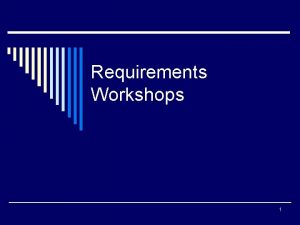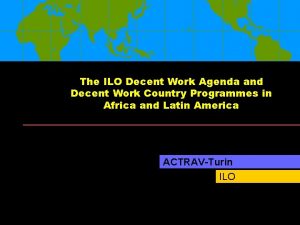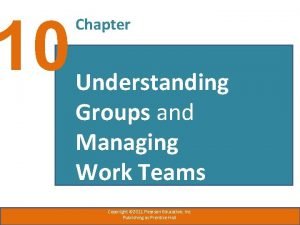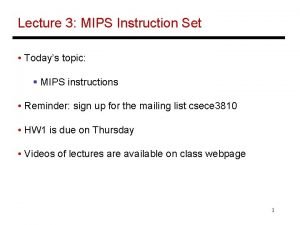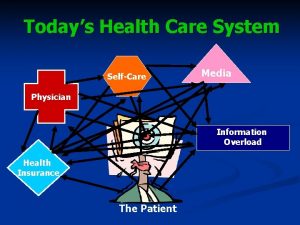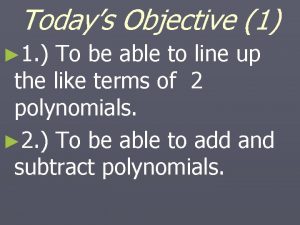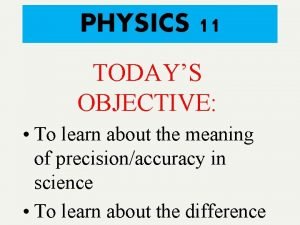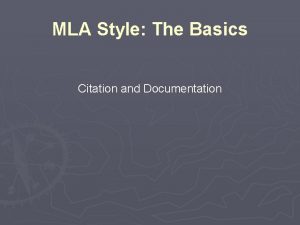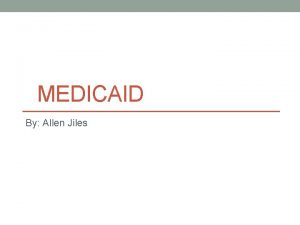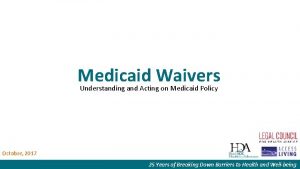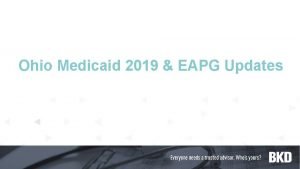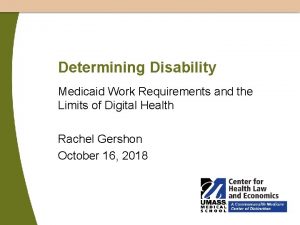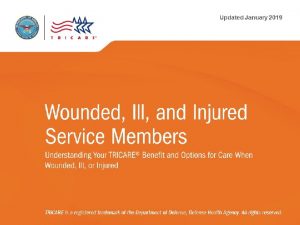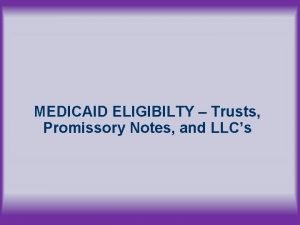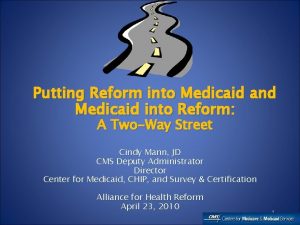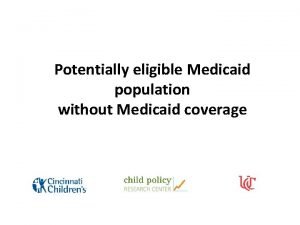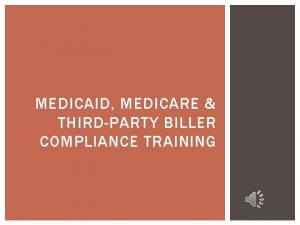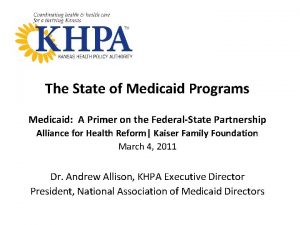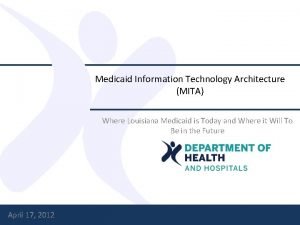Understanding Medicaid and Work Requirements Todays Agenda Understanding



































- Slides: 35

Understanding Medicaid and Work Requirements

Today’s Agenda: Understanding Medicaid • Basics of Medicaid • Who Does Medicaid Cover • Medicaid Expansion • Work Requirements in Medicaid • Challenges with Work Requirements • Resources • Core Messaging Preview • Questions & Discussion 2

Basics of Medicaid

Basics of Medicaid: What is It? Medicaid is… • Health insurance for: • Low-income children, adults, seniors, and people with disabilities. • Covering: • 97 million Americans, including 33 million children (38%) and 1. 75 million veterans (10%). • Paying for: • Necessary medical services for families and individuals who do not have access to private health insurance. • Helping people: • Get and stay healthy, so they can work and take care of their families. 4

Basics of Medicaid: How is it Paid For? How is it Funded? The federal government pays for the majority of Medicaid Costs, with states contributing a smaller amount. State & Federal Medicaid Funding, FY 2016 5 • The federal share of Medicaid spending ranges between 50% and 83% of a state’s typical Medicaid costs, based on each state’s per capita income. • Certain populations, including children and expansion enrollees are eligible for enhanced federal financing of 90% or more. • In 2016, the federal government paid for 63% of total Medicaid costs.

Basics of Medicaid: Services What Services are Covered? How is Care Delivered? • Medicaid does not provide direct services Inpatient and outpatient hospital care Physician Services Preventative Care Pregnancy and childbirth Medical and surgical dental Medical and surgical vision Laboratory and x-ray Long-term services and supports • Most state Medicaid programs cover additional, optional services on top of the services listed above. 6 • Instead pays doctors, hospitals, nursing homes, etc. that deliver services to patients. • Fee-For-Service • Traditionally, state Medicaid programs have reimbursed providers directly, paying a preset rate for each covered service. • Managed Care • Many states contract with private insurance companies, paying them a monthly rate regardless of what services are actually delivered.

Basics of Medicaid: What People Think Polling Data • • 7 73% of Americans have favorable opinion of Medicaid 80% of all voters oppose funding cuts to Medicaid 87% Medicaid is important for children of parents struggling to get by 74% Medicaid is important for low income families given how hard it is to afford basics

Basics of Medicaid: Key Takeaways Medicaid is Health Insurance • Medicaid makes it possible for millions of low income children and adults to get and stay healthy making sure they can work and take care of their families • It allows them to see a doctor whey they are sick, get check-ups, buy medications and go to the hospital without fear of choosing between their health and groceries or paying rent • The majority of Americans think Medicaid is valuable and important to protect 8

Who Does Medicaid Cover

Who Does Medicaid Cover: Eligibility & Populations Eligibility Groups Mandatory Populations: • Federal law requires state Medicaid programs to cover certain “mandatory” populations. Children up to age 18 • States are guaranteed federal financial support for the costs of covering these populations, regardless of enrollment or utilization. • Medicaid recipients must be U. S. citizens and residents of the state in which they are applying for benefits. 10 Pregnant women Parents Adults over age 65 People with disabilities

Does Medicaid Cover: Who Does Medicaid Cover: Income Requirements Medicaid eligibility is tied to income, which changes by eligibility group

Who Does Medicaid Cover: Enrollment and Spending Enrollment vs. Costs of Medicaid Enrollees by Group (% of total) Enrollment & Costs • Children make up the largest group of Medicaid recipients, but account for the least total spending. • Seniors and people with disabilities are the smallest group of enrollees, but are a major cost driver. 12

Who Does Medicaid Cover: Key Takeaways Medicaid Makes the Difference • Medicaid makes the difference for millions of hard-working, low income Americans who don’t earn enough to pay for health insurance or aren’t offered health insurance through their jobs. • It fills the gap when people fall on hard times and ensures they have access to healthcare as they recover from an illness or care for a sick child. • If people are going to get back on their feet, find a job with a sustainable wage or recover from a debilitating injury, they need access to healthcare so they can get healthy and move forward. 13

Medicaid Expansion

Medicaid Expansion: Changes on the Horizon Research • Record lows in uninsured rates • Access improved, utilization shifted toward primary care, outcomes improved • Numerous economic benefits • Rural hospitals able to stay open • Increased family financial stability for housing and food • Medical debt significantly reduced • Employer sponsored insurance premiums lower in expansion states 15 Better Care The Institute for Healthcare Improvement “Triple Aim” Better Health Lower Costs

Medicaid Expansion: A Growing Divide State Differences • Losing out on federal funding • Not able to address most pressing health issues • Coverage is a key determinant of economic self-sufficiency • States with expansion saw uninsured decrease by half 16

Medicaid Expansion: The Changing Landscape What’s Next? • Ballot measures • Governor’s Race Implications • Waivers 17

Medicaid Expansion: Americans Support Expansion Among Adults in 18 Non-Expansion States Should Expand Keep Medicaid as it is Source: Kaiser Family Foundation Health Tracking Poll, June 2017 18 Support for Medicaid Expansion in Key States ID 71% FL 67% NC 66% OK 63% TX 67% UT* 59% VA 83% Source: School of Public Policy, University of Maryland *Boise State Survey

Medicaid Waivers Work Requirements 19

Work Requirements: What is a Waiver? Federal law allows states to ‘waive’ certain Medicaid regulations in 1115 Demonstration Waivers. These waivers allow states to design and test approaches to better serve Medicaid populations. To implement 1115 waivers, states must meet certain requirements: Must be budget neutral The program cannot spend more than it would have otherwise Requires public comment Must happen on the state and federal level and comments must be addressed before approval by HHS. Must advance “the objectives of Medicaid” Waivers must improve access to medical care for low-income individuals. 20

Work Requirements: Who Does it Affect? • Work requirements target Medicaid enrollees who are nondisabled, unemployed adults. • Regardless to economic circumstances, they are required to work at least 80 hours/month. • States that restrict eligibility often create exemptions for individuals who are: Facing significant medical issues Full time students Primary caretaker of family member 21

Work Requirements: What are the Challenges? 22 • States implementing work requirements are facing legal action as opponents argue they violate federal law and have harmful impacts on Medicaid populations. • Most Medicaid enrollees are already working, but in low-wage jobs that may be part time, have constantly shifting schedules or be seasonal in nature. For those not working, many face significant barriers to finding and keeping work. • Complex reporting requirements can be burdensome, putting people at risk of losing coverage.

Work Requirements: What are the Challenges? • Reporting requirements create complex red tape for all enrollees, putting them at risk of losing benefits due to difficulties or errors in the reporting process. • Access to healthcare is precursor to and support for employment. People need to be healthy to work and stay employed. • Work requirements do not address the barriers to work people face, creating additional burdens on families already struggling. • Work requirements are not a good use of state resources. They are extremely costly to implement and maintain. 23

Work Requirements: State Examples of Difficulties Arkansas Kentucky • In 3 months, 4, 300 lost coverage. • Only 6% successfully reported coverage • Blocked by a federal judge • 100, 000 would lose coverage Indiana, New Hampshire and Others • What next? • Lawsuits? • Disenrollment? 24

Work Requirements: Key Takeaways Work Requirements Will Cause Harm • There will be negative impacts on children, people with disabilities & serious chronic illnesses, and veterans • Taking away coverage is the wrong approach to helping people find and keep jobs • The proposed changes will create more red tape and government bureaucracy 25

Resources: Kaiser Foundation State Fact Sheets Data includes: • Spending • Waivers • Enrollment • Eligibility Limits • Trends • Benefits • Physician Fees • Demographics • & MORE! 26

United Way Engagement How Can We Add Value to the Discussion 27

United Way Engagement • Educate Volunteers and Key Decision Makers on Medicaid • Share local data and stories on who is impacted • Write Op-eds and Letters to the Editor • Testify at State Legislative Hearings on Medicaid Waivers • Participate in State & Federal Public Comment Periods 28

UW Core Messaging

Broad Themes to Reinforce 1. Supporting the Value of Work 2. Medicaid is Health Insurance 3. Medicaid Supports Working Families 30

Core Positioning Statement: Supporting the Value of Work United Way supports work as a core American value, and the main way to provide for our families and bring dignity to our daily lives. • Instead of taking away a person’s healthcare because they don’t work enough hours in a month, we need to focus on policies that improve our economy, provide more jobs at a sustainable wage and help train people for those jobs.

Secondary Positioning Statement: Medicaid is Health Insurance Medicaid makes the difference for millions of hard-working Americans who don’t’ earn enough to pay for health insurance or aren’t offered health insurance through their jobs. • It fills the gap when people fall on hard times and ensures they have access to healthcare as they recover from an illness or care for a sick child. • If people are going to get back on their feet, find a job with a sustainable wage or recover from a debilitating injury, they need access to healthcare so they can get healthy and move forward.

Secondary Positioning Statement: Medicaid Supports Working Families Medicaid makes it possible for millions of low income children and adults to get and stay healthy, making sure they can work and take care of their families. • It allows them to see a doctor when they are sick, get check-ups, buy medications and go to the hospital without fear of choosing between their health and groceries or paying rent.

Q&A

Thank you. 35
 Todays agenda
Todays agenda Agenda sistemica y agenda institucional
Agenda sistemica y agenda institucional Requirements workshop
Requirements workshop How to gather client requirements
How to gather client requirements Global agenda for social work and social development
Global agenda for social work and social development 4 pillars of decent work
4 pillars of decent work Mmsea act of 2007
Mmsea act of 2007 Understanding work teams
Understanding work teams Todays generations
Todays generations There is class today
There is class today Todays with apostrophe
Todays with apostrophe Todays worldld
Todays worldld Define radient energy
Define radient energy Todays globl
Todays globl Todays wordlw
Todays wordlw Chapter 13 marketing in today's world answer key
Chapter 13 marketing in today's world answer key Todays plan
Todays plan Todays sabbath lesson
Todays sabbath lesson Todays sabbath school lesson
Todays sabbath school lesson Boys football walsall
Boys football walsall Todays health
Todays health How to identify simile
How to identify simile No thats not it
No thats not it Today's objective
Today's objective Todays whether
Todays whether Todays vision
Todays vision Todays objective
Todays objective Planetary positions today
Planetary positions today Mla first page
Mla first page Todays final jeopardy answer
Todays final jeopardy answer Standing handcuffing techniques
Standing handcuffing techniques Todays weather hull
Todays weather hull Todays objective
Todays objective Wat is todays date
Wat is todays date Todays objective
Todays objective Define todays
Define todays


